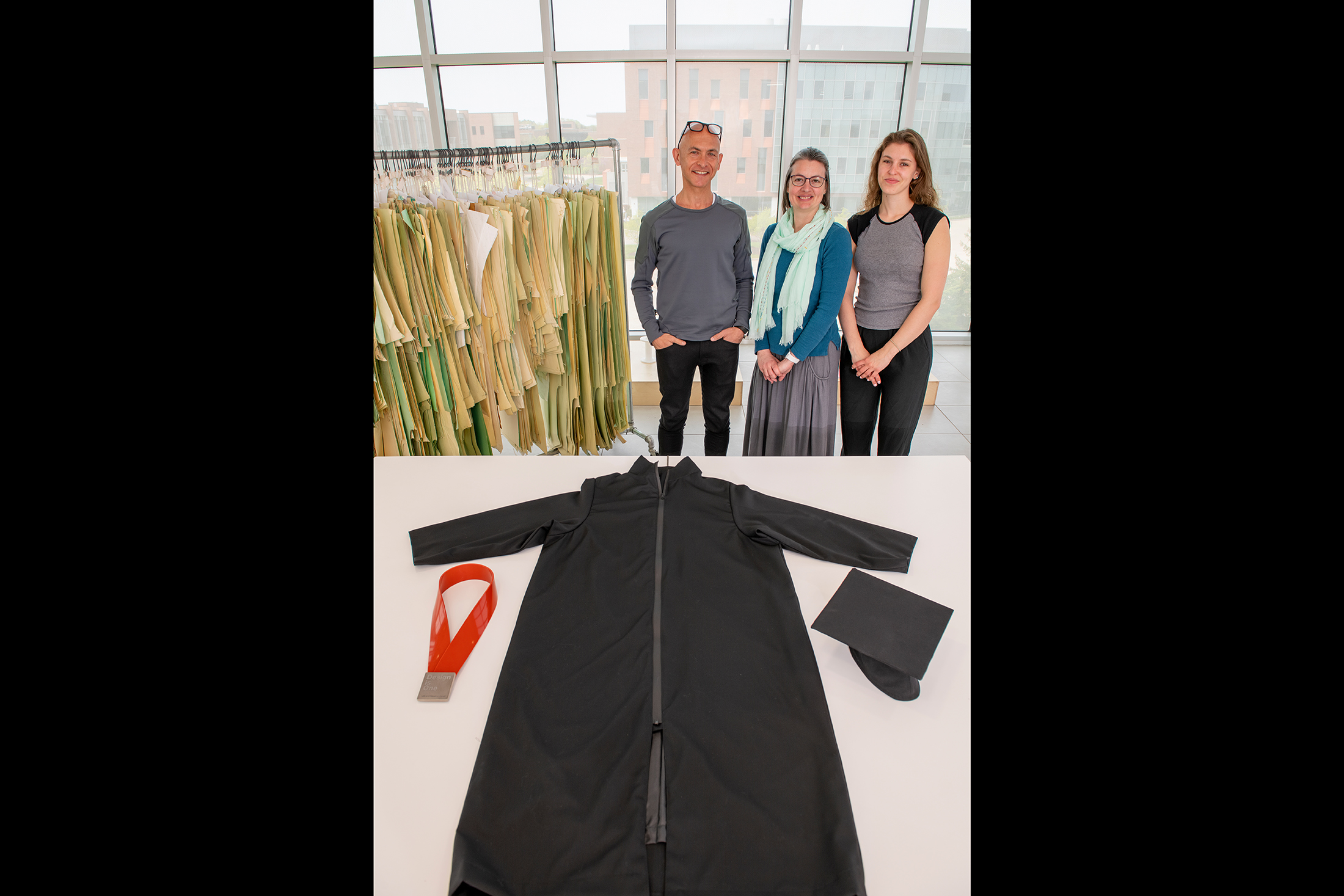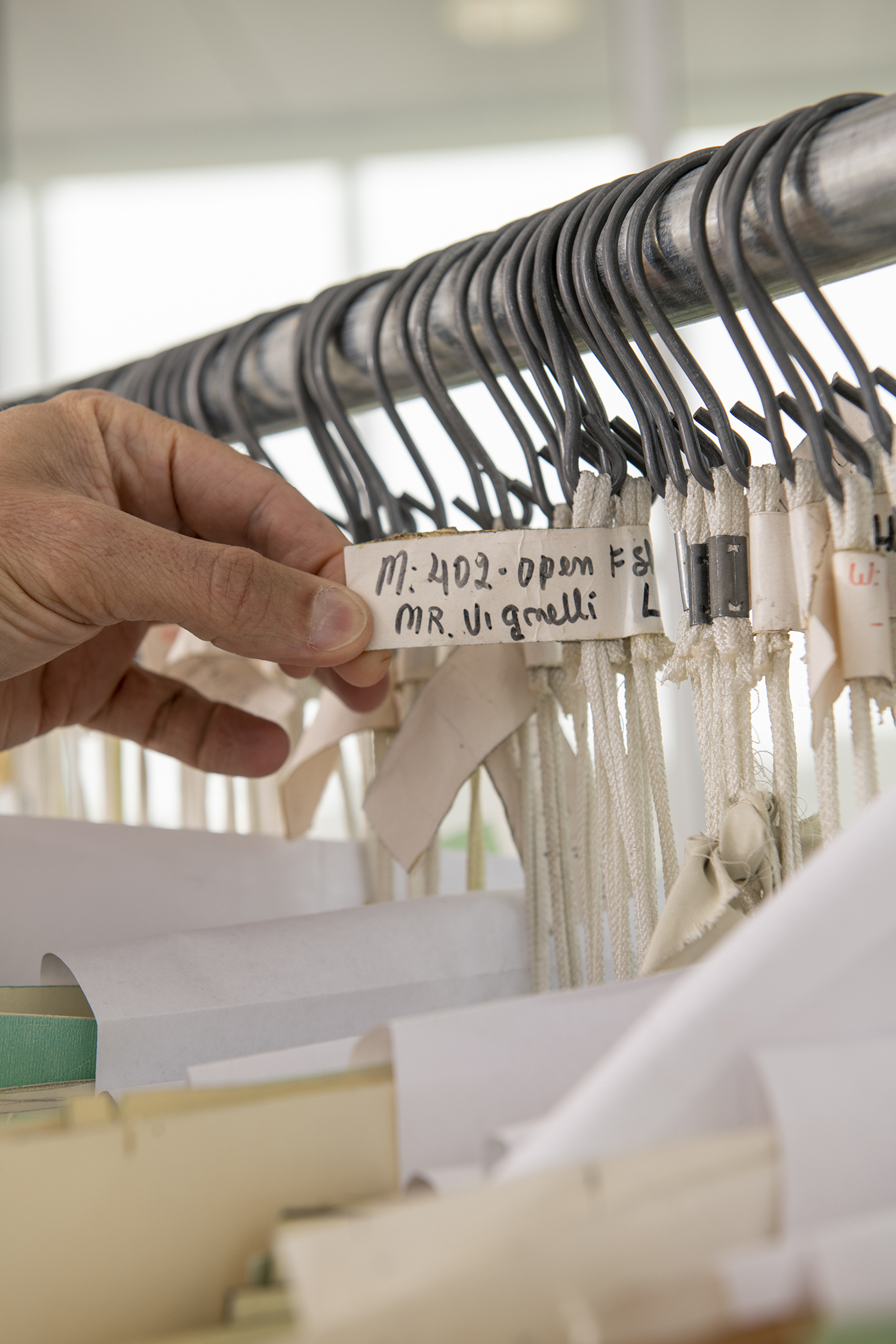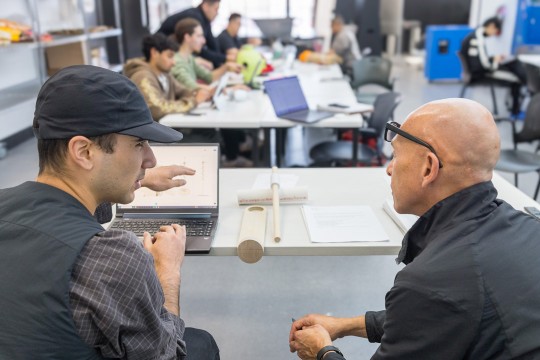Vignelli-inspired regalia to debut at commencement
Elizabeth Lamark
Upper photo: From left, Josh Owen, Melissa Dawson and Clare Maxwell stand beside the fabric from the Vignelli archives used to make regalia (lower photo) that reflects the Vignelli design ethos. Owen will wear the cap and gown at the College of Art and Design commencement ceremony.
When thinking about soft goods, the range of possibilities excites Melissa Dawson.
Dawson, the undergraduate program co-director of industrial design, is a textile design expert who has spent her professional design and academic careers espousing the technological complexities of successful soft product design.
“It’s what keeps me interested in soft goods — every project is different, every fabric is different,” said Dawson, an associate professor in the School of Design.
Dawson’s latest soft goods challenge was to bring the Vignelli ethos to the RIT College of Art and Design commencement ceremony stage.
Dawson teamed with fourth-year industrial design student Clare Maxwell to design a modern cap and gown based on pattern blocks and design philosophies of design masters Lella and Massimo Vignelli. The ceremonial uniform will be worn at commencement by Josh Owen, the Vignelli Distinguished Professor of Design and director of RIT’s Vignelli Center for Design Studies.
Not only does the regalia possess the same minimalistic elegance Lella and Massimo were known for in their work, the fabric used came right from their collection.
With the Vignelli Center housing the professional archives of the Vignellis, the outer, visible portion of the cap and gown is made of black wool directly left over from the clothing line Lella and Massimo designed and launched in the 1990s. The gown’s interfacing is also from the archives, making the whole ensemble authentically Vignelli.
Owen said additional original fabric from the Vignelli clothing was used after being donated more recently to RIT by Valentina Vignelli, Lella and Massimo’s daughter.
Elizabeth Lamark
The fabric used to make the cap and gown came right from the Vignelli archives.
The end result is a sleek, slender, custom shape that is less voluminous than conventional graduation regalia.
“We tried to streamline it a bit — reduce the bulk, reduce how cumbersome it is, and match that Vignelli perspective,” Dawson said.
During her time at RIT, Maxwell has designed soft goods products in Dawson’s soft studio classes. Heavy involvement with the cap-and-gown research project was another way for Maxwell to expand her interest and capabilities in apparel design.
“I enjoy the parameters,” Maxwell said. “It’s been fun to watch fittings where Melissa is like, ‘Maybe we should put interfacing on the zipper so it doesn’t bunch up, or if we take it in this way it will sit flatter.’ Just learning by osmosis a little bit. It’s been a good challenge to present new ideas when we’re designing the collar or we’re thinking about the length.”
Owen will pair the cap and gown with the Vignelli Distinguished Professor medal that reflects the Vignelli design ethos. The regalia was designed to accentuate the medal, engraved with the Vignellis’ famous “Design is One” slogan.
“In my view, good design is always built upon lessons learned from the past, leveraged towards an optimistic view of the future,” Owen said. “By observing changes in behavior and culture we can lean into the opportunities that emerge with new materials and technology to improve quality of life. There is no better way to do this than to work with colleagues and students who bring perspectives from different specializations and life experiences to bear on the myriad challenges that face us today, regardless of scale or application.”
Dawson said research into graduation regalia weighed into design decisions. She, Maxwell and Owen discussed effective ways to display standard gown symbolism — which includes details such as velvet stripes signifying certain education levels — across both the gown and medal while still adhering to tradition.
“My favorite part has been the conversations looking at what those traditions are and what is important, what we need to keep,” Dawson said. “There is a lot of history there, from the shape and the original materials used. Do you need the big sleeves? Do you need the length? Do you need a collar or not? There was interesting exploration.
“It makes you think, it makes you examine what you value.”



